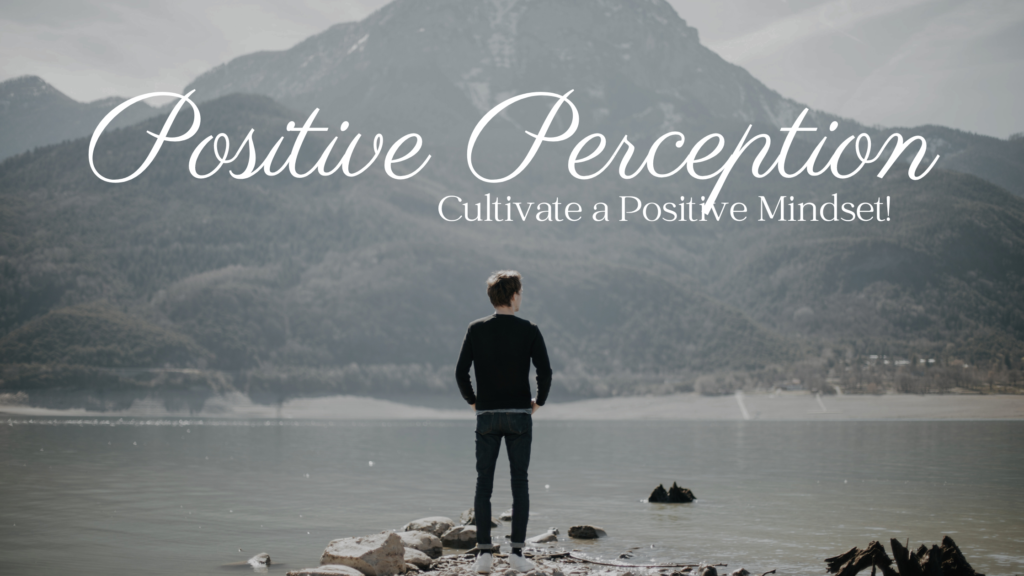Developing a positive perception of ourselves and others can be a challenging journey, but it is a crucial one. Positive perception can lead to better relationships, improved communication, and a more fulfilling life. In this article, we will guide you through a step-by-step journey to develop a positive perception.
The journey to developing a positive perception starts with self-awareness. We must become aware of our thoughts, emotions, and behaviors. By doing so, we can identify negative patterns and replace them with positive ones. We can also learn to recognize our strengths and weaknesses, which can help us build confidence and self-esteem.
Once we have developed self-awareness, we can move on to improving our perception of others. This involves becoming aware of our biases and stereotypes and learning to empathize with others. By doing so, we can build better relationships and improve our communication skills. We will guide you through each step of this journey, offering practical tips and strategies to help you develop a positive perception of yourself and others.
Understanding Perception
What is Perception?
Perception is the process of interpreting and organizing sensory information from our environment. It is how we make sense of the world around us. Perception is not just limited to our five senses, but also includes our experiences, emotions, and beliefs. Our perception can be influenced by various factors such as culture, language, and past experiences.
Why is Perception Important?
Perception is important because it shapes our understanding of the world and influences our behavior. Our perception determines how we interpret and respond to situations, people, and events. It affects our communication with others and our ability to build relationships. Perception also plays a crucial role in decision-making, problem-solving, and critical thinking.
The Link Between Perception and Reality
Perception and reality are closely linked, but they are not the same thing. Perception is subjective and can be influenced by personal biases, stereotypes, and assumptions. Reality, on the other hand, is objective and based on facts and evidence. Our perception of reality can be distorted by our own beliefs and experiences, leading to misunderstandings and misinterpretations.
It is important to be aware of our own perception and to try to understand the perception of others. By developing empathy and actively listening to others, we can improve our communication and build stronger relationships. We can also improve our perception by challenging our own biases and assumptions and seeking out different perspectives.
Overall, perception is a complex and important aspect of our daily lives. By understanding how perception works and how it affects our behavior, we can develop a more positive and accurate perception of the world around us.
Developing a Positive Perception
Developing a positive perception is a journey that requires constant effort and awareness. It involves identifying negative perceptions, challenging them, and cultivating positive perceptions.
Identifying Negative Perceptions
The first step in developing a positive perception is to identify negative perceptions. Negative perceptions are thoughts or beliefs that are limiting, self-defeating, or inaccurate. They can be about ourselves, others, or the world around us.
To identify negative perceptions, we need to pay attention to our thoughts and feelings. We can ask ourselves questions like:
- What am I thinking right now?
- Is this thought helpful or harmful?
- Is there evidence to support this thought?
- What would I say to a friend who had this thought?
By becoming aware of our negative perceptions, we can start to challenge them.
Challenging Negative Perceptions
Once we have identified our negative perceptions, we can start to challenge them. Challenging negative perceptions means examining the evidence for and against them and looking for alternative explanations.
To challenge negative perceptions, we can ask ourselves questions like:
- Is there evidence to support this thought?
- Is there evidence to contradict this thought?
- What would be a more accurate or helpful way to think about this situation?
By challenging our negative perceptions, we can start to see things in a more positive light.
Cultivating Positive Perceptions
The final step in developing a positive perception is to cultivate positive perceptions. Cultivating positive perceptions means focusing on the positive aspects of ourselves, others, and the world around us.
To cultivate positive perceptions, we can:
- Practice gratitude by focusing on the things we are thankful for.
- Focus on our strengths and accomplishments.
- Look for the positive in others and in situations.
- Practice positive self-talk by replacing negative thoughts with positive ones.
By cultivating positive perceptions, we can start to see the world in a more positive light and develop a more positive outlook on life.
In summary, developing a positive perception is a journey that involves identifying negative perceptions, challenging them, and cultivating positive perceptions. By becoming aware of our negative perceptions, challenging them, and focusing on the positive, we can develop a more positive outlook on life.
Practical Strategies for Developing Positive Perception
Developing a positive perception is an ongoing journey that requires consistent effort. Here are some practical strategies that we can implement to cultivate a positive mindset:
Practicing Gratitude
One effective way to develop a positive perception is by practicing gratitude. We can start by taking a few minutes each day to reflect on the things we are grateful for in our lives. This could be as simple as appreciating the warm sunshine on our face or the sound of birds chirping outside our window. We can also keep a gratitude journal to write down the things we are thankful for, which can help us focus on the positive aspects of our lives.
Setting Realistic Goals
Another strategy for developing a positive perception is by setting realistic goals. By setting achievable goals, we can experience a sense of accomplishment and boost our self-confidence. It’s important to break down larger goals into smaller, more manageable tasks, which can make them feel less overwhelming. We can also celebrate our progress along the way, which can help us stay motivated and positive.
Engaging in Positive Self-Talk
The way we talk to ourselves can have a significant impact on our perception. By engaging in positive self-talk, we can shift our mindset from negative to positive. This could involve replacing negative self-talk with positive affirmations, such as “I am capable” or “I am worthy.” We can also challenge negative thoughts by asking ourselves if they are really true and finding evidence to support more positive beliefs.
Developing Self-Compassion
Finally, developing self-compassion is an important strategy for cultivating a positive perception. This involves treating ourselves with kindness and understanding, rather than harsh self-criticism. We can practice self-compassion by acknowledging our mistakes and flaws without judgment, and by treating ourselves with the same kindness and compassion that we would offer to a good friend.
By implementing these practical strategies, we can develop a more positive perception and improve our overall well-being.
Building Self-Esteem and Confidence
Building self-esteem and confidence is an essential part of developing a positive perception of ourselves. When we recognize our worth, develop a positive self-concept, and overcome self-doubt, we can build a solid foundation for a healthy and happy life.
Recognizing Your Worth
Recognizing our worth is the first step towards building self-esteem and confidence. We must understand that we are valuable and worthy individuals, no matter what our past experiences might have been. We can recognize our worth by acknowledging our strengths, accomplishments, and positive qualities. We can also practice self-compassion and treat ourselves with kindness and respect.
Developing Positive Self-Concept
Developing a positive self-concept is crucial to building self-esteem and confidence. We can develop a positive self-concept by focusing on our strengths, values, and positive qualities. We can also challenge negative self-talk and replace it with positive affirmations. It’s essential to be realistic and acknowledge our weaknesses, but we should not let them define us. Instead, we can work on improving them and focus on our strengths.
Overcoming Self-Doubt
Overcoming self-doubt is a significant hurdle when it comes to building self-esteem and confidence. We can overcome self-doubt by challenging our negative thoughts and beliefs, practicing self-compassion, and taking action despite our fears. It’s essential to remember that making mistakes and experiencing failures is a natural part of the learning process. We can learn from our mistakes and failures and use them as opportunities for growth and self-improvement.
In conclusion, building self-esteem and confidence is a process that takes time and effort. By recognizing our worth, developing a positive self-concept, and overcoming self-doubt, we can build a solid foundation for a happy and healthy life. Remember, we are all valuable and worthy individuals, and we deserve to treat ourselves with kindness, respect, and compassion.
Improving Communication and Relationships
Effective communication is essential for building positive relationships and improving perception. When we communicate well, we are more likely to understand and empathize with others, which can help us build stronger connections. Here are some tips for improving communication and relationships:
Active Listening
Active listening is a crucial component of effective communication. When we actively listen, we give our full attention to the speaker and make an effort to understand their perspective. This can help us build trust and empathy, which are essential for positive relationships.
To practice active listening, we can:
- Avoid interrupting the speaker
- Ask clarifying questions to ensure understanding
- Use nonverbal cues, such as nodding or maintaining eye contact, to show engagement
- Summarize what the speaker said to demonstrate comprehension
Effective Communication Skills
Effective communication skills are essential for building positive relationships and improving perception. When we communicate clearly and respectfully, we are more likely to be understood and respected in return.
To improve our communication skills, we can:
- Use “I” statements to express our thoughts and feelings
- Avoid blaming or accusing language
- Be specific and clear in our communication
- Use active listening skills to demonstrate engagement and understanding
Building Positive Relationships
Building positive relationships is essential for improving perception and creating a supportive environment. When we have positive relationships, we are more likely to feel understood, valued, and supported.
To build positive relationships, we can:
- Show empathy and understanding towards others
- Be respectful and considerate in our communication
- Express gratitude and appreciation for others
- Make an effort to connect with others on a personal level
By improving our communication skills and building positive relationships, we can improve our perception and create a more supportive and positive environment.
Overcoming Negative Thinking Patterns

Negative thinking patterns can prevent us from developing a positive perception of ourselves and the world around us. These patterns can lead to feelings of anxiety, depression, and low self-esteem. However, with the right techniques, we can overcome these patterns and develop a more positive outlook on life.
Identifying Negative Thinking Patterns
The first step in overcoming negative thinking patterns is to identify them. Common negative thinking patterns include black and white thinking, overgeneralization, catastrophizing, and personalization. We can recognize these patterns by paying attention to our thoughts and emotions.
For example, if we find ourselves thinking in extremes, such as “I always fail” or “I never get anything right,” we may be engaging in black and white thinking. If we assume that one negative event means everything is terrible, we may be catastrophizing. By identifying these patterns, we can start to challenge them.
Challenging Negative Thoughts
Once we have identified our negative thinking patterns, we can challenge them. This involves questioning the evidence for our negative thoughts and considering alternative explanations. We can ask ourselves questions such as:
- Is this thought based on fact or opinion?
- Is there evidence to support this thought?
- Are there alternative explanations for what is happening?
- What would I say to a friend who had this thought?
By challenging our negative thoughts, we can start to see them in a more balanced and realistic way.
Replacing Negative Thoughts with Positive Ones
Finally, we can replace our negative thoughts with positive ones. This involves finding evidence to support a more positive outlook and actively looking for the good in situations. We can also practice gratitude by focusing on what we are thankful for.
For example, if we find ourselves thinking “I am a failure,” we can challenge this thought by thinking about our successes and accomplishments. We can also reframe the situation by thinking “I may have failed this time, but I can learn from my mistakes and do better next time.”
In conclusion, overcoming negative thinking patterns is a key step in developing a positive perception of ourselves and the world around us. By identifying, challenging, and replacing our negative thoughts with positive ones, we can improve our mental health and overall well-being.
Maintaining a Positive Perception

Once we have developed a positive perception, it is important to maintain it. Here are some tips to help us stay on track.
Practicing Self-Reflection
Self-reflection is an important tool for maintaining a positive perception. We can take some time each day to reflect on our thoughts, feelings, and behaviors. This can help us identify any negative patterns that may be creeping in and make adjustments accordingly. We can also use self-reflection to celebrate our successes and acknowledge our strengths.
Developing Resilience
Resilience is the ability to bounce back from setbacks. It is an important trait to develop if we want to maintain a positive perception. We can build resilience by practicing self-care, seeking support from others, and reframing negative experiences in a positive light. It is important to remember that setbacks are a normal part of life and we can learn from them and grow stronger as a result.
Staying Committed to Positive Change
Maintaining a positive perception requires a commitment to positive change. We must be willing to continue to learn and grow, even when it is difficult. This means staying open to feedback, being willing to try new things, and being patient with ourselves as we work towards our goals. It is important to remember that change is a process and it takes time.
By practicing self-reflection, developing resilience, and staying committed to positive change, we can maintain a positive perception and continue to grow and thrive.
Conclusion
In conclusion, developing positive perception is a journey that requires consistent effort and self-reflection. By following the steps outlined in this article, we can improve our ability to perceive others accurately and positively.
It’s important to remember that perception is subjective and can be influenced by a variety of factors, including our own biases and past experiences. By engaging in perception checking and being open to different interpretations, we can overcome these obstacles and develop a more accurate understanding of the people around us.
Additionally, improving our self-perception is an important part of developing positive perception. By focusing on our strengths and accomplishments, we can build our self-esteem and become more confident in our interactions with others.
Finally, it’s important to remember that developing positive perception is an ongoing process. We may encounter challenges and setbacks along the way, but by remaining committed to our journey and continuing to practice the skills outlined in this article, we can continue to grow and improve our ability to perceive others positively.
High-Five, You Made It!
Congratulations, dear reader! You’ve powered through to the end, which either means you’re genuinely into mindfulness or just a true sucker for good content (we’re betting on both). Here’s a virtual high-five for your determination! 🖐️
But hey, don’t rush off just yet! Make sure you leave your thoughts, experiences, and favorite mindful moments in the comments or in our forums. Who knows, your insightful morsel might just be the revelation someone else needs. Plus, who doesn’t love a good chit-chat about the journey of the mind?
Don’t forget to share this post with your pals on social media. If they ask, just tell them it was too awesome not to share. And remember, these posts are like your favorite TV show, they get better with every new season (or in our case, update). So come back often, there’s always something fresh!
Until next time, keep being the mindful rockstar you are. 🎸🌟



